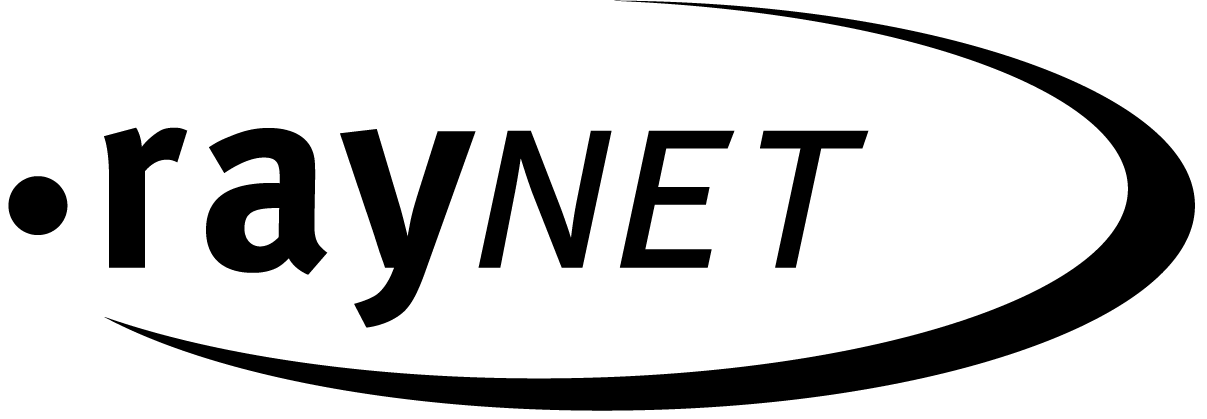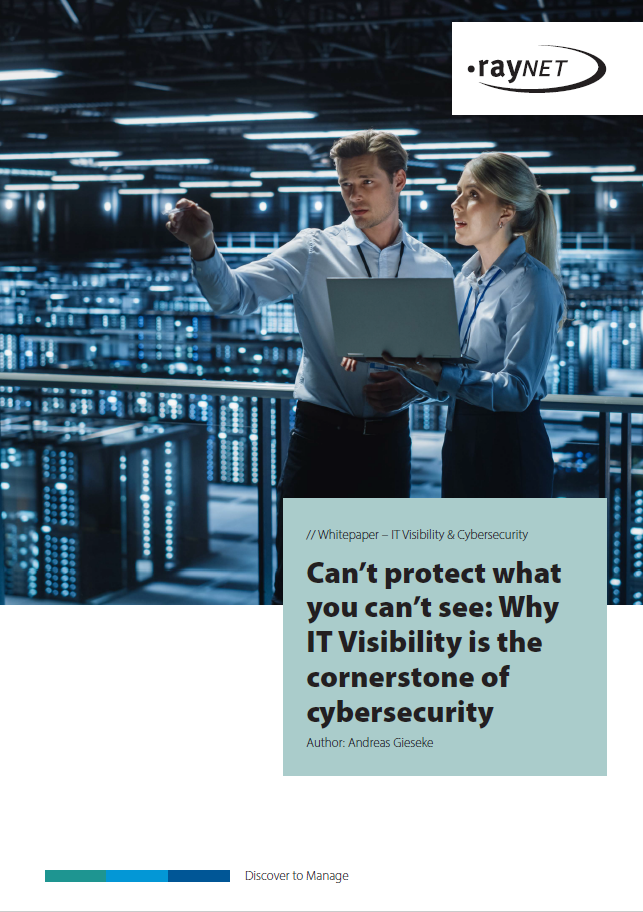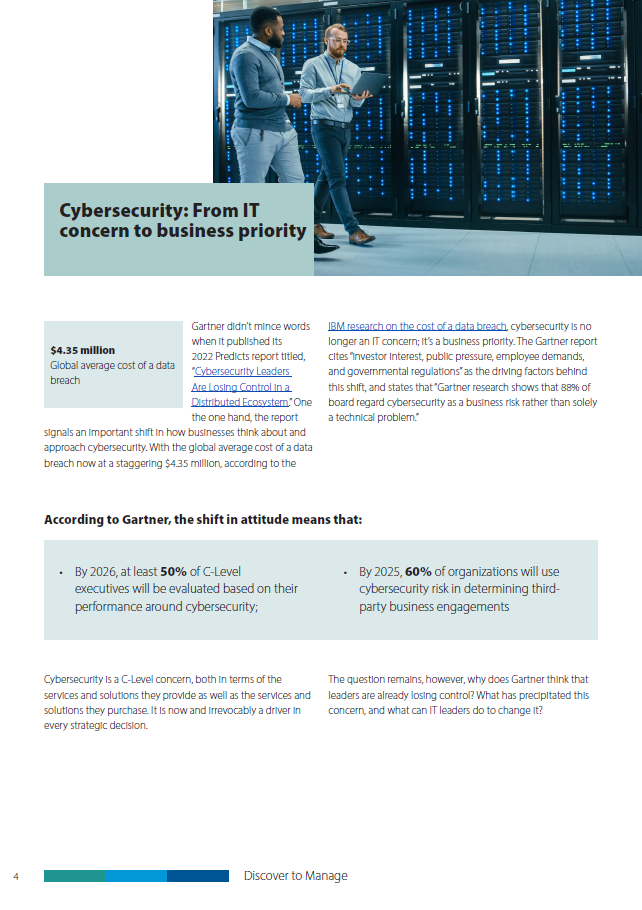// Blog
What is IT Visibility and why is it indispensable for companies today?
Date: February 14th, 2024
There’s an iconic scene in Daniel Craig’s first turn as James Bond in Casino Royale, where Bond protests to the gift of a dinner jacket from Vesper Lynd. “I already have a dinner jacket,” says Bond, surprised and perhaps even a little hurt. Lynd, pointing to the jacket, confidently but casually intones, “There are dinner jackets, and there are dinner jackets. This is the latter.”
We know from an earlier scene that Lynd, a government accountant, is perceptive, sly, and subtle, and she skewers Bond for the cut of his suit – “you actually think human beings dress like that”. She has a superior edge in matters of taste and style. The unschooled observer might not know the difference, but to the initiated, this dinner jacket will indicate to the elite players in a high-stakes poker tournament in Montenegro that Bond belongs.
As part of an origin story, we’re witnessing Bond’s transformation from a blunt instrument to the debonair MI-6 man of action, embodied by Sean Connery, Roger Moore, Pierce Brosnan and so many others.
But what does James Bond have to do with IT Visibility? Well, “There’s IT Visibility, and there’s IT Visibility. Raynet is the latter.”
IT Visibility: comprehensive, granular, and enriched
IT Visibility, you might have heard, is something that many vendors claim to do. But few, it seems, are the dinner jacket. It’s one thing to find and list most of the assets in an enterprise architecture; it’s another altogether to provide comprehensive, granular, and enriched insights into complex and decentralized infrastructures that allow you to make data-driven decisions about:
- IT budgeting & planning
- Cost & compliance control
- Cybersecurity & vulnerability management
- Application portfolio management
And that’s what IT visibility should be. IT Visibility is the comprehensive, granular, and enriched view of an IT environment, no matter how large or complex, that allows IT leaders to make data-driven decisions about their IT investment.
How do you get IT Visibility?
Genuine IT Visibility means doing three essential things right:
- Data completeness – With the right array of discovery and inventory methods and tools, you can get a full set of relevant data from any system in your environment. A great discovery tool will come equipped with fit-for-purpose connectors for all the most important and widely used enterprises systems and cloud solution as well as the flexibility to quickly create new connectors. This makes getting the data you need quick and easy.
- Data quality – Having the data is one thing, but turning it into high quality data is another. How can you do this? By aggregating and normalizing the data, you can compare data sources to check for gaps, errors, duplicate information, and other issues that lower data quality. Once you’ve unmuddied the waters, you can start to see the big picture.
- Data-driven actions – Visibility is meaningless unless you can do something with it. The data should provide clear answers to specific questions, and it should allow you to take action to solve the problems. Automated reports and dashboards give you the insight you need to act on all your most important IT management challenges and initiatives.
While a blunt instrument might think the data is enough, an expert will understand that the data needs be high-quality to yield meaningful results. The Unified Data Platform aggregates and normalizes the data to give it a standard form, to eliminate duplicates and find data gaps, and it enriches the data with information from its market-leading Technology Catalog.
Author:
Related links:
Share blog:
Can't protect what you can't see: Why IT Visibility is the cornerstone of cybersecurity
In this whitepaper, we’ll show you how blind spots can weaken and even threaten your infrastructure. But we’ll also show you how IT Visibility can:
- Improve your security strategy
- Reveal hidden gaps and blind spots in your existing security measures
- Maintain business flexibilities
- Ensure your competitive edge
What are the consequences of not having complete, high quality data?
Your IT initiatives are a house of cards, and the foundation is complete and high quality IT asset data. Without it, your initiatives topple, and you’re left you could run into any number of significant financial and cybersecurity problems.
Nice metaphor, but what are the real consequences?
Cyber Asset Attack Surface Management, for instance, is the practice of keeping complete and accurate inventories of all your IT assets and regularly checking them for vulnerabilities and other security gaps. If the data is incomplete, if devices or software products or versions are missing from the inventory, then you are leaving your IT open to attacks that could cripple your business. A single unsecured device or vulnerable piece of software could be an invitation for malicious actors to break into your systems, steal data, or even lock you out.
As Gartner’s recent “Market Guide to Software Asset Management Tools” made clear, complete discovery, aggregation and normalization are essential to any SAM program. Without high quality data, SAM and ITAM initiatives such as license management and application rationalization can leave you with significant blind spots, inaccurate counts, and a poor understanding of what’s in your portfolio. These problems can in turn lead to higher costs, wasted spend, increased support and maintenance expenditures, and inflexibilities in onboarding new solutions. These gaps hinder growth and can pull the brakes on your competitive engine.
It’s the reason why, as Gartner says, “40% of initiatives fail due to poor data quality.”
Data is key to comprehensive IT Visibility
Visibility allows users to move between the details and the big picture, to understand how unique elements affect the strategy and how the strategy can drive smaller decisions such as deprovisioning apps, modernizing legacy infrastructure, and mitigating critical vulnerabilities.
By combining the data with insights from the market, and information from software contracts, commercial and security, and other sources, Raynet provides the data to make your IT initiatives successful. It gives users clarity not available in other tools, and the ability to focus on specific problems such as Vulnerability Monitoring or Application Rationalization.
There’s IT Visibility, and then there’s IT Visibility. With Raynet, you get the latter.
// Blog
What is IT Visibility and why is it indispensable for companies today?
Reading time: 4 minutes
February 14th, 2024 | Andreas Gieseke
There’s an iconic scene in Daniel Craig’s first turn as James Bond in Casino Royale, where Bond protests to the gift of a dinner jacket from Vesper Lynd. “I already have a dinner jacket,” says Bond, surprised and perhaps even a little hurt. Lynd, pointing to the jacket, confidently but casually intones, “There are dinner jackets, and there are dinner jackets. This is the latter.”
We know from an earlier scene that Lynd, a government accountant, is perceptive, sly, and subtle, and she skewers Bond for the cut of his suit – “you actually think human beings dress like that”. She has a superior edge in matters of taste and style. The unschooled observer might not know the difference, but to the initiated, this dinner jacket will indicate to the elite players in a high-stakes poker tournament in Montenegro that Bond belongs.
As part of an origin story, we’re witnessing Bond’s transformation from a blunt instrument to the debonair MI-6 man of action, embodied by Sean Connery, Roger Moore, Pierce Brosnan and so many others.
But what does James Bond have to do with IT Visibility? Well, “There’s IT Visibility, and there’s IT Visibility. Raynet is the latter.”
IT Visibility: comprehensive, granular, and enriched
IT Visibility, you might have heard, is something that many vendors claim to do. But few, it seems, are the dinner jacket. It’s one thing to find and list most of the assets in an enterprise architecture; it’s another altogether to provide comprehensive, granular, and enriched insights into complex and decentralized infrastructures that allow you to make data-driven decisions about:
- IT budgeting & planning
- Cost & compliance control
- Cybersecurity & vulnerability management
- Application portfolio management
And that’s what IT visibility should be. IT Visibility is the comprehensive, granular, and enriched view of an IT environment, no matter how large or complex, that allows IT leaders to make data-driven decisions about their IT investment.
How do you get IT Visibility?
Genuine IT Visibility means doing three essential things right:
- Data completeness – With the right array of discovery and inventory methods and tools, you can get a full set of relevant data from any system in your environment. A great discovery tool will come equipped with fit-for-purpose connectors for all the most important and widely used enterprises systems and cloud solution as well as the flexibility to quickly create new connectors. This makes getting the data you need quick and easy.
- Data quality – Having the data is one thing, but turning it into high quality data is another. How can you do this? By aggregating and normalizing the data, you can compare data sources to check for gaps, errors, duplicate information, and other issues that lower data quality. Once you’ve unmuddied the waters, you can start to see the big picture.
- Data-driven actions – Visibility is meaningless unless you can do something with it. The data should provide clear answers to specific questions, and it should allow you to take action to solve the problems. Automated reports and dashboards give you the insight you need to act on all your most important IT management challenges and initiatives.
While a blunt instrument might think the data is enough, an expert will understand that the data needs be high-quality to yield meaningful results. The Unified Data Platform aggregates and normalizes the data to give it a standard form, to eliminate duplicates and find data gaps, and it enriches the data with information from its market-leading Technology Catalog.
Can't protect what you can't see: Why IT Visibility is the cornerstone of cybersecurity
In this whitepaper, we’ll show you how blind spots can weaken and even threaten your infrastructure. But we’ll also show you how IT Visibility can:
- Improve your security strategy
- Reveal hidden gaps and blind spots in your existing security measures
- Maintain business flexibilities
- Ensure your competitive edge
What are the consequences of not having complete, high quality data?
Your IT initiatives are a house of cards, and the foundation is complete and high quality IT asset data. Without it, your initiatives topple, and you’re left you could run into any number of significant financial and cybersecurity problems.
Nice metaphor, but what are the real consequences?
Cyber Asset Attack Surface Management, for instance, is the practice of keeping complete and accurate inventories of all your IT assets and regularly checking them for vulnerabilities and other security gaps. If the data is incomplete, if devices or software products or versions are missing from the inventory, then you are leaving your IT open to attacks that could cripple your business. A single unsecured device or vulnerable piece of software could be an invitation for malicious actors to break into your systems, steal data, or even lock you out.
As Gartner’s recent “Market Guide to Software Asset Management Tools” made clear, complete discovery, aggregation and normalization are essential to any SAM program. Without high quality data, SAM and ITAM initiatives such as license management and application rationalization can leave you with significant blind spots, inaccurate counts, and a poor understanding of what’s in your portfolio. These problems can in turn lead to higher costs, wasted spend, increased support and maintenance expenditures, and inflexibilities in onboarding new solutions. These gaps hinder growth and can pull the brakes on your competitive engine.
It’s the reason why, as Gartner says, “40% of initiatives fail due to poor data quality.”
Data is key to comprehensive IT Visibility
Visibility allows users to move between the details and the big picture, to understand how unique elements affect the strategy and how the strategy can drive smaller decisions such as deprovisioning apps, modernizing legacy infrastructure, and mitigating critical vulnerabilities.
By combining the data with insights from the market, and information from software contracts, commercial and security, and other sources, Raynet provides the data to make your IT initiatives successful. It gives users clarity not available in other tools, and the ability to focus on specific problems such as Vulnerability Monitoring or Application Rationalization.
There’s IT Visibility, and then there’s IT Visibility. With Raynet, you get the latter.
Share this blog post:




